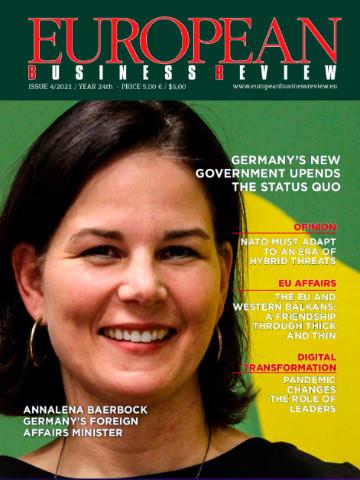Returning Europe to competitiveness through energy productivity and efficiency
This is a smart way to drive a return to competitiveness and growth in the EU.

They noted that growth has not picked up enough to deliver a marked improvement in job creation and that international developments add to existing uncertainty about the European Union’s economic prospects.
by
Ingrid Holmes*
The Juncker Commission’s investment plan is an unprecedented opportunity to improve the EU’s energy productivity and efficiency. In May, the wise folks at DG ECFIN (Economic and Financial Affairs) warned again of the fragile state of the economic recovery in Europe.
They noted that growth has not picked up enough to deliver a marked improvement in job creation and that international developments add to existing uncertainty about the European Union’s economic prospects. These include volatility in commodity and energy prices, exchange rates and financial markets, persistence of geopolitical tensions in the EU neighborhood and reduced economic activity in emerging economies.
The EU’s response to these ongoing challenges – notably the ‘Investment Plan for Europe’ – is the right one. The focus on driving investment in a very practical way in the short-term – through the European Strategic Fund for Investment (EFSI) and technical assistance for project developers - is important.
But equally important will be the longer term reforms the Commission enacts (the second part of the Investment Plan) to deepen the single market and sustain growth in the longer term through innovation and improved efficiencies across capital, energy and digital markets in the EU.
This is a smart way to drive a return to competitiveness and growth in the EU. And yet there is currently a yawning and obvious gap in how the Plan is being implemented. In focusing on facilitating investment in traditional big infrastructure such as gas pipelines, fibre optic cable and airports, we will miss the opportunity to deliver the equally important but smaller and more widely distributed energy investments that could play such a big role in driving growth.
This includes investment in increased levels of energy efficiency and smarter management of energy demand that can deliver significant competiveness gains through increasing Europe’s energy productivity. Granted, some interesting projects on energy efficiency are coming through – including support for industrial energy efficiency in Italy, a new regions-led energy efficiency financing vehicle in France, smart meter roll out in the UK – but this will have a minimal impact on the volume of projects coming through for financing overall.
There is an estimated gap of up to €100 billion per year to meet the EU’s 2020 goal of increasing the energy efficiency of the EU economy by 20% - a fivefold increase in current investment levels is needed to close the gap in the buildings sector alone.
The work of the Energy Efficiency Financial Institutions Group (EEFIG) has confirmed that there is not a lack of capital or interest in deploying capital to boost energy efficiency and demand side management in Europe. But there is a wide range of market, institutional, economic and financial barriers that stand in the way of an energy efficient Europe.
Removing these barriers in a systemic way will be key to creating the investment-friendly environment Vice-President Katainen has stated is needed – and will be as important as the specific projects the EFSI supports. As such, European Commission officials should take the Katainen at his word.
Moving forward, the upcoming Heating and Cooling Strategy currently being produced by DG ENER officials and the related suite of expected proposals to reform the Energy Efficiency Directive, Energy Performance in Building Directive, Energy Market Design (Electricity and Gas), 2030 governance and Ecodesign Directive must set the scene not just for incremental improvements of energy efficiency policies that have gone before. They must look at how other enabling reforms could be enacted across the wider range of EU initiatives currently in play.
The traditional focus on energy efficiency policy making needs to be expanded to look more systematically at how energy productivity increases can be enabled through wider structural reforms that sit more traditionally within economic policies, financial regulation, energy market reforms and institutional arrangements.
A non-exhaustive list of reforms and interventions includes: State Aid reforms to improve financing conditions for energy efficiency and smart energy projects supported through EFSI and other public funding sources; ring-fencing 50% of capacity within the European Investment Advisory Hub to support project/fund preparation and implementation in member states; reviewing current debt and deficit restrictions in the Treaty for Stability Coordination and Governance and associated regulation to create flexibility for public spending on energy efficiency to support the delivery of National Financing Strategies; and related to this, undertaking a review of the accounting treatment of public and private investment in demand side and energy efficiency to consider the case for off-balance sheet treatment.
Progress in breaking down these barriers could be surveyed through the European Semester Process with the Annual Growth Survey. This could include a focus on progress towards improving energy productivity levels, Country In Depth Reviews to include an assessment of levels of energy imports and the contribution made by energy imports to current account deficits.
It could also focus on the potential for improvements to energy productivity levels through improving the functioning of energy markets and measures to improve energy efficiency. The European Commission could even consider the case for including improvements in average energy productivity levels as a key Macroeconomic Imbalances Indicator.
Finally, in developing the Heating and Cooling Strategy and related legislation, the Energy Efficiency Directive needs to be recast to play a strengthened framework role to ensure that it can, along with the Energy Performance in Buildings Directive, Ecodesign Directive and related legislation, comprehensively address the wider range of specific market, institutional and economic barriers identified in the EEFIG Report.
This focus on ensuring reforms will materially improve the business case and pipeline for demand management and energy efficiency investments.
It is only through this comprehensive approach – which should be a key element of the Investment Plan – that policy makers can meet investors half way, and start to unlock the investment that is undoubtedly ready and willing to be deployed in this sector, as the EEFIG report has shown, and boost Europe’s energy productivity and return to competitiveness.
*Ingrid Holmes is the director of environmental NGO E3G
**First published at Euractiv.com



 By: N. Peter Kramer
By: N. Peter Kramer

